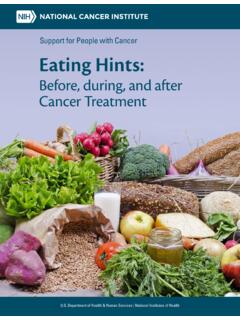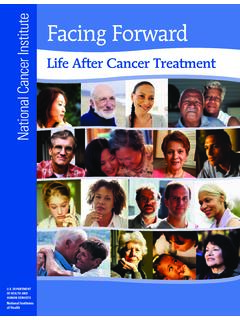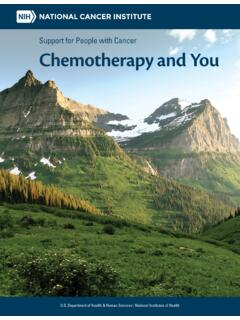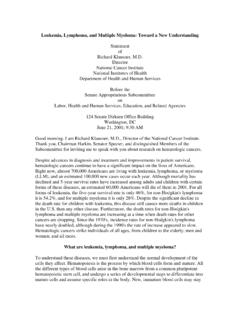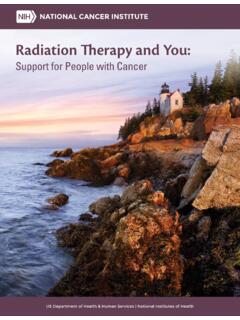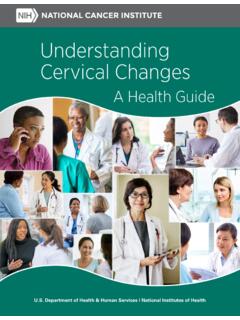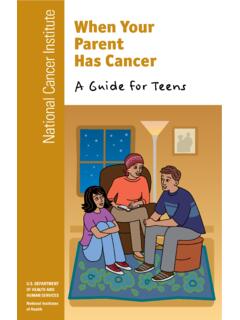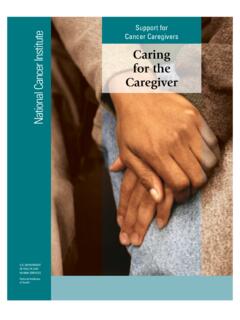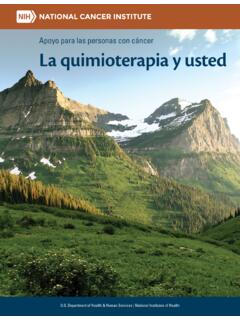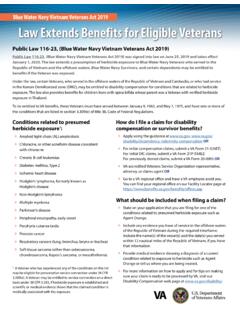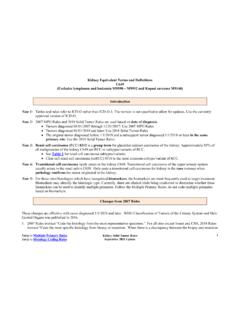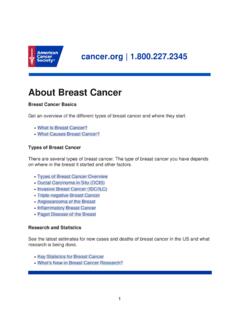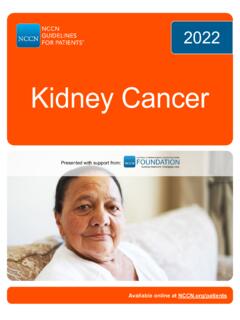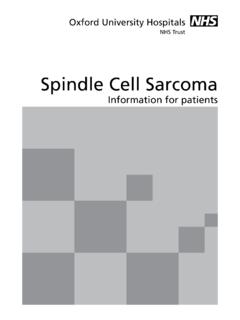Transcription of National Cancer Institute Children with Cancer
1 National Cancer DEPARTMENT OF HEALTH AND HUMAN SERVICESN ational Institutesof HealthChildren with Cancer A Guide for ParentsbiTypes of Childhood Cancer ..2 Diagnosing and Staging Cancer ..4 Talking with Your Child ..8 Hospitals That Specialize in Treating Children with Cancer ..14 Clinical Trials ..23 Cancer Treatments and Side Effects ..30 Common Health Problems ..45 Introduction ..1 Children with Cancer : A Guide for ParentsFinding Ways to Cope and Stay Strong ..52 Helping Your Child to Cope ..55 Helping Brothers and Sisters ..60 Getting Organized ..63 Survivorship and Follow-up Care ..66If Treatments Aren t Working ..72 Looking Forward ..75 Practices That Help Children : Integrative Medicine Approaches ..76 Medical Tests and Procedures ..79 DIAGNOSISLIFE AFTERRESOURCESTREATMENTSUPPORTiiAcknowle dgmentsWe would like to thank the many pediatric oncologists, nurses, social workers, dieticians, and other health care professionals who contributed to the development of this guide.
2 We are especially grateful to the parents of Children with Cancer who shared their experiences and insights in order to help note that for easy reading, we alternate between he and she to refer to a child with When we first learned Lilly had leukemia, we walked around in a daze for weeks and barely slept. After the initial shock, we decided to learn all we could about this type of Cancer . We also joined a support group at our hospital. Lilly is a fighter it has been 5 years now and she is Cancer free. IntroductionBeing told that your child has Cancer is extremely difficult. Many parents say they felt overwhelmed and confused in the first days and weeks after their child s diagnosis. This guide has both medical information and coping advice that can help your child and your in mind: You are not alone . Your child s treatment team has many specialists who will care for the physical and emotional needs of your child.
3 They will also help support your family during this difficult time. More Children than ever before survive childhood Cancer . Most parents have good reason to be hopeful that their child will get better. Knowledge is power . Many people and resources are available to help you learn about the type of Cancer your child has, how it s treated, and what to guide aims to give parents practical support that can help you find a doctor, talk with your child, help your family to cope, organize medical and insurance information, and learn about additional resources. It also includes information to help you learn more about specific types of childhood Cancer , tests and procedures, treatments and clinical trials, health issues during treatment, steps to take if treatment isn t working, and guide can also be viewed online or (1-800-422-6237) www.
4 Cancer .gov Learn about the exact type of Cancer your child has and how it s treated. Some or even much of what you have heard about Cancer will not apply to your child. We felt better when we knew how treatment could help our child. More about cancerNormal cells grow and divide in an orderly process. The body makes more cells only when it needs them. When normal cells grow old or get damaged, they die, and new normal cells take their place. Abnormal ( Cancer ) cells grow and divide in an uncontrolled fashion. For example, new cells form when the body doesn t need them, and old or damaged cells don t die when they should. Cancer cells can invade and damage nearby tissues and spread to other parts of the body. The spread of Cancer from one part of the body to another is called section provides general information about childhood Cancer .
5 Here are some points to consider as you start to learn more: Cancer is a group of many related diseases, not one disease . The word Cancer is used to describe a group of diseases in which abnormal cells divide without control, invade nearby tissues, and spread to other parts of the body through the blood and lymph systems. Cancers in Children are different from cancers in adults . The parts of the body in which Cancer occurs most often are different for Children and adults. The most common childhood cancers Types of Childhood CancerNormal cells Abnormal cells are leukemia, brain and other central nervous system tumors, and lymphoma. Together, these cancers account for more than half of all cancers diagnosed in Children but only a small percentage of the cancers diagnosed in adults. The causes of childhood Cancer are not well understood.
6 Although a small number of cases of childhood Cancer are due to genetic abnormalities, the causes of most childhood cancers are unknown. Children of all ages, races, and economic backgrounds get Cancer .More Children survive Cancer now than ever before . New and better treatments help many Children with Cancer . Today, more than 80 percent of Children and adolescents (under the age of 20) who are diagnosed with Cancer survive for at least 5 years after their diagnosis. However, survival rates for some childhood cancers are still low. Much of the improvement in childhood Cancer survival rates is due to clinical trials that have taken place over the past four of specialists treat Children with Cancer . These teams are most often found at university or Children s hospitals that are members of the Children s Oncology Group.
7 3 DIAGNOSISC hildhood cancersThe most common childhood cancers include: Brain Cancer Brain and spinal cord tumors begin in the tissues of the brain and spinal cord. The brain and spinal cord make up the central nervous system (CNS). Germ cell tumors often begin in the testicles or ovaries, although they can form almost anywhere in the body. These types of tumors include: extracranial germ cell tumors (tumors form outside the brain) central nervous system germ cell tumors Leukemia starts in the blood-forming tissue of the bone marrow. Types of leukemia include: acute lymphoblastic leukemia (ALL) acute myeloid leukemia (AML) Lymphoma starts in the lymphatic system, which is part of the body s immune system. There are several types: Hodgkin lymphoma non-Hodgkin lymphomaNeuroblastoma forms in nerve tissue in the neck, spinal cord, or adrenal gland.
8 Sarcoma is Cancer that forms in the bone, muscle, or soft tissues. There are several types: Ewing sarcoma forms in the bone or soft tissues osteosarcoma forms in the bone soft tissue sarcoma forms in muscle, fat, fibrous tissue, blood vessels, or other supporting tissues of the body rhabdomyosarcoma is the most common type of soft tissue sarcoma in Children , it forms in the muscle tissuesWilms tumor and other childhood kidney tumors Wilms tumor forms in the types of childhood Cancer For detailed information about these and other childhood cancers see our Pediatric Cancer Treatment Summaries (PDQ ). Each summary includes information about signs of specific types of Cancer , tests that may be used to make a diagnosis, and treatment choices. Related resources Alphabetical List of Pediatric Cancer Treatment Summaries (PDQ ) Childhood Cancers41-800-4- Cancer (1-800-422-6237) www.
9 Cancer .gov Before the biopsy, my daughter and I learned what was going to happen. We went to a large Children s hospital that had expertise in diagnosing and treating Children with Cancer . This section explains how Cancer is diagnosed in Children . It will help you learn what tests are used to diagnose Cancer and how staging systems, risk groups, and grades may be used to plan treatment for your child and to make a symptomsThe early symptoms of childhood Cancer are often similar to ones that are commonly seen in other illnesses. These symptoms may include fever, feeling tired, swollen glands, or weight loss. Others, such as bruising or tender joints or bones, may lead a parent to suspect an injury. When these signs and symptoms last or are severe, the doctor may order tests to check for Cancer or other illnesses. Tests and proceduresThe following tests and procedures are used to diagnose Cancer in Children .
10 The type of test done depends on your child s symptoms, age, medical history, and the type of Cancer doctors think it may be. A physical examination and blood tests Scans are imaging tests that make pictures of areas inside the body. Types of scans include CT scan, MRI, PET scan, x-ray, and ultrasound. A radiologist is a doctor who reviews the scans and sends a report of the findings to your child s doctor. A biopsy is a procedure in which samples of cells or tissue are removed and then checked to find out if Cancer cells are present. When possible, biopsies should be done at a hospital that specializes in diagnosing Cancer in Children . A pathologist will study the cells or tissue samples taken during the biopsy and write a pathology report . This report describes what the cells or tissues look like when examined with a microscope and includes the diagnosis.
